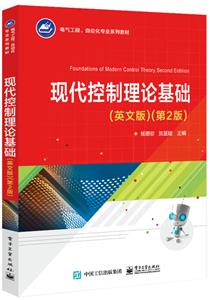-
>
中医基础理论
-
>
高校军事课教程
-
>
思想道德与法治(2021年版)
-
>
毛泽东思想和中国特色社会主义理论体系概论(2021年版)
-
>
中医内科学·全国中医药行业高等教育“十四五”规划教材
-
>
中医诊断学--新世纪第五版
-
>
中药学·全国中医药行业高等教育“十四五”规划教材
现代控制理论基础(英文版)(第2版) 版权信息
- ISBN:9787121414039
- 条形码:9787121414039 ; 978-7-121-41403-9
- 装帧:一般胶版纸
- 册数:暂无
- 重量:暂无
- 所属分类:>>
现代控制理论基础(英文版)(第2版) 本书特色
现代控制理论是控制类专业学生必须掌握的重要基础理论。本书是编者在多年双语教学实践经验基础上,参考国外优秀教材,按照我国课程教学大纲的要求编写的。 全书共分8章,主要内容包括状态空间分析法、数学基础知识、线性动态系统的状态响应、线性系统的可控性和可观性、李亚普若夫稳定性分析、线性系统的状态综合(状态反馈、输出反馈和状态观测器)和*优控制的基本方法。除第1章外,其余各章均编写了多个实验例题,同时还配有一定数量的练习题和思考题,帮助学生了解和掌握理论方法及其在工程实践中的应用。 本书主要作为普通高等院校控制类专业本科生和非控制类专业(如电子类、机电类)研究生的教材和参考书,也可供广大工程科技人员学习参考。
现代控制理论基础(英文版)(第2版) 内容简介
现代控制理论是控制类专业学生必须掌握的重要基础理论。本书是编者在多年双语教学实践经验基础上,参考国外很好教材,按照我国课程教学大纲的要求编写的。 全书分8章,主要内容包括状态空间分析法、数学基础知识、线性系统的状态响应、线性系统的可控性和可观性、李雅普若夫稳定性分析、线性系统的状态综合(状态反馈、输出反馈和状态观测器)和很优控制的基本方法。除章外,其余各章均编写了多个应用型例题,同时还配有一定数量的练习题和思考题,帮助学生了解和掌握理论方法及其在工程实践中的应用。 本书可作为普通高等院校控制类专业本科生和非控制类专业(如电子类、机电类)研究生的教材与参考书,也可供广大工程科技人员学习参考。
现代控制理论基础(英文版)(第2版) 目录
1.1 Historical Review and Classical Control Theory
1.1.1 Historical Review of Automatic Control
1.1.2 Classical control theory
1.2 Modern Control Theory
1.3 Design of Control Systems
1.4 Outline of This Book
Chapter 2 Preliminary Mathematical Knowledge
2.1 Foundations of matrix algebra
2.1.1 Matrices
2.1.2 Algebraic operations with matrices
2.1.3 Matrix Operations
2.2 Vectors and Vector Spaces
2.2.1 Vector
2.2.2 Vector Spaces and Subspaces
2.3 Linear Algebra
2.3.1 Eigenvalue and Eigenvector of A Square Matrix
2.3.2 Linear Algebraic Equations
2.3.3 Similarity Transformation
2.3.4 Diagonal Form and Jordan Form
2.3.5 Cayley-Hamiton Theorem
2.3.6 Definiteness of A Scalar Function and Quadratic Form
Exercises
Chapter 3 State Variables and the State-Space Description of Dynamic Systems
3.1 State-Space Representation of Dynamic Systems
3.1.1 State and State Variables
3.1.2 State-Space Representation
3.1.3 Block Diagrams and Simulation Diagrams
3.2 Obtaining State Equations
3.2.1 From the Block Diagram
3.2.2 From Input-Output Representation
3.2.3 Equivalence Transformation of State-Space Representation
3.3 Transfer Function And Realizations
3.4 State-Space Representation of Linear Discrete-Time Systems
3.5 Summaries
Exercises
Problems
Chapter 4 Time Response of Linear Systems
4.1 Solution of LTI State Equations
4.1.1 Linear Homogeneous State Equations
4.1.2 The State Transition Matrix
4.1.3 Linear Nonhomogeous State Equations
4.2 Numerical Solution of State Equations
4.3 Solution of Linear Discrete-Time State Equations
4.4 Discretization of Continuous-Time Systems
Exercises
Problems
Chapter 5 Controllability and Observability
5.1 Corollaries of Cayley-Hamilton Theorem
5.2 Controllability and Observability of LTI Systems
5.2.1 Controllability Definition and Rank Criterion
5.2.2 Observability Definition and Rank Criterion
5.2.3 Controllable Canonical Form and Observable Canonical Form
5.2.4 Principle of Duality
5.3 Structural Decomposition of LTI systems
5.4 Controllability, Observability and Transfer Function
5.5 Controllability and Observability of Discrete-Time Systems
5.5.1 Controllability of Discrete-Time Systems
5.5.2 Observability of Discrete-Time Systems
5.5.3 Controllability and Observability After Sampling
Exercises
Problems
Chapter 6 Lyapunov Stability
6.1 Preliminary Examples
6.2 Stability Concepts
6.2.1 Equilibrium State
6.2.2 Stability Definitions
6.3 First Method of Lyapunov
6.3.1 Eigenvalue Criterion for Linear Time-invariant System
6.3.2 Eigenvalue Criterion for Linearized Time-invariant Systems
6.4 Second Method of Lyapunov
6.5 Lyapunov Equation
Exercise
Problems
Chapter 7 State Feedback and State Observer
7.1 State Feedback and Output Feedback
7.1.1 State Feedback
7.1.2 Output Feedback
7.2 Pole Placement using State feedback
7.3 Pole placement using Output Feedback
7.4 State Observer
7.4.1 Full-Dimensional Observer
7.4.2 Reduced-Dimensional State Observer
7.5 Feedback From Estimated States
7.6 The Engineering Applications of State Feedback and Observer
7.6.1 State Feedback Controller Design For The Inverted Pendulum
7.6.2 Asymptotic Tracking And Disturbance Rejection
7.6.3 System Stabilization
7.6.4 System Decoupling
Exercises
Problems
Chapter 8 Optimal Control
8.1 Problem Formulation
8.2 Preliminaries:The extremum problem of functional
8.2.1 Functional and The Calculus of Variation
8.2.2 The Extremum Problem of Functional Without Constraints
8.3 The Variational Approach to Optimal Control Problems
8.4 Minimum Principle and Its Application
8.4.1 Pontryagin's Minimum Principle
8.4.2 Application of Minimum Principle
Exercises
Problems
Answers to Selected Exercises
Experiment 1: Modeling and Stability Analysis of the Inverted Pendulum System
Experiment 2: Design State Feedback Controller for the Inverted Pendulum System
Bibliography
现代控制理论基础(英文版)(第2版) 作者简介
杨慧珍,博士,副教授。1978年3月参加工作。1991/8–1995/7,西北工业大学,工业自动化,学士;1995/9–1998/3,西北工业大学,水中兵器,硕士;2000/9–2005/5, 西北工业大学, 武器系统与运用工程,博士;1998/4-至今,西北工业大学,航海学院,教师;2008/12-2009/12,美国佐治亚理工学院,电子与计算机工程系,访问学者。参加的学术组织及任职:中国仿真学会,理事。个人及集体荣誉:2014年,西北工业大学"最满意教师”称号;2013年陕西省精品课程"鱼雷自动控制系统”重要成员。所承的科研项目:主持省部级基金项目3项,参与军科委,国家自然科学基金委等国家级项目2项;西北工业大学《现代控制理论基础》全英文教学课程建设项目;西北工业大学《现代控制理论基础》教学与考核模式改革项目;西北工业大学《现代控制理论基础》课程思政建设项目; 杨惠珍,牛津大学EMI全英文教学培训的启示与实践,高教学刊,2020.5。教学成果获奖情况:**导航控制一体化仿真系统及关键技术,国防科学技术进步奖二等奖,2011年,排名第2;**雷控制系统,国防科学技术进步奖二等奖,2009年,排名第7;**分布交互及海洋战场视景仿真技术,国防科学技术奖二等奖,2006年,排名第3。出版著作情况:杨惠珍,贺昱曜,Foundation of Modern Control Theory/现代控制理论基础,西北工业大学出版社,2016.1.1;康凤举,杨惠珍,高立娥,现代仿真技术与应用(第2版),国防工业出版社,2006.1.1(教育部遴选的全国研究生推荐教材。);吴旭光,杨惠珍,王新民,计算机仿真技术(第二版),化学工业出版社,2008.9.1(化学工业部优秀教材二等奖,普通高等教育"十一五”国家级规划教材)。
-
食品添加剂
¥33.5¥45 -
VB语言程序设计
¥29.9¥39.8 -
C语言程序设计习题与实验指导
¥9.1¥18 -
地下建筑结构-(第三版)-(赠课件)
¥49.4¥55 -
模具制图
¥37.8¥49 -
工程机械结构认知
¥10.5¥22


















